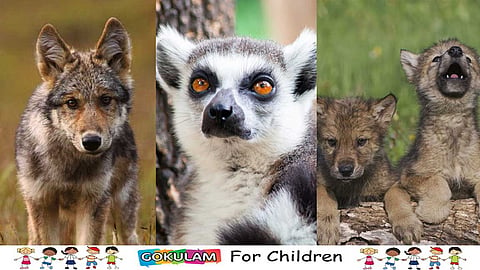
- முகப்பு
- கல்கி
- மங்கையர் மலர்
- தீபம்
- கோகுலம்/Gokulam
- முக்கிய பிரிவுகள்முக்கிய பிரிவுகள்
- தொகுப்புகள்தொகுப்புகள்
- Premium

Endangered Animals – How can we help?
Endangered animals are species that are at risk of becoming extinct. Extinction occurs when there are no more individuals of that species left in the wild or in captivity.
Every species plays an important role in the ecosystem, and their loss can have significant impacts on the environment and other living creatures. Today, many animals around the world are endangered due to various human activities. Understanding the reasons behind their endangerment and knowing how we can help is crucial to protecting these animals. As citizens of the future, maintaining this biodiversity is our responsibility.
Causes of Endangerment of animal species:
1. Habitat Loss: This is the leading cause of endangerment. As humans expand cities, farms, and infrastructure, they destroy the natural habitats of many animals. Deforestation, wetlands draining, and converting wild areas into agricultural land leave animals with no place to live and find food.
2. Pollution: Pollution of air, water, and soil can have devastating effects on wildlife. Chemicals and waste products can poison animals or destroy their habitats. For example, marine animals are severely affected by plastic pollution in the oceans.
3. Climate Change: Changes in the climate can alter the habitats and food sources of many species. Some animals are not able to adapt quickly enough to the changing temperatures and weather patterns, which can lead to their decline.
4. Over hunting and Poaching: Illegal hunting and poaching for animal parts such as ivory hide, fur, and bones, as well as overfishing, significantly reduce animal populations. Some species are targeted for pet trade, reducing their numbers in the wild.
5. Invasive Species: When non-native species are introduced into a new environment, they can outcompete, prey on, or bring diseases to the native species, leading to the decline of the latter.
How to Help Endangered Animals:
While the situation may seem dire, there are several ways we can help endangered animals:
1. Protecting Habitats: Supporting and establishing protected areas like national parks and wildlife reserves is essential. These areas provide safe environments where animals can live, breed, and thrive without the threat of habitat destruction.
2. Supporting Conservation Organizations: Many organizations work tirelessly to protect endangered species through conservation programs, research, and public education. Donating to or volunteering with groups like the World Wildlife Fund (WWF), Wildlife Conservation Society (WCS), and local conservation initiatives can make a big difference.
3. Reducing Pollution: Minimizing waste, recycling, and using eco-friendly products help reduce pollution. Participating in or organizing clean-up drives can also protect wildlife from harmful pollutants.
4. Promoting Sustainable Practices: Choosing sustainably sourced products, such as seafood certified by the Marine Stewardship Council, helps reduce the impact on endangered species. Supporting businesses that practice sustainable agriculture and forestry also contributes to habitat preservation.
5. Advocating for Laws and Policies: Supporting laws and regulations that protect endangered species and their habitats is vital. Writing to lawmakers, signing petitions, and participating in advocacy campaigns can help create stronger protections for wildlife.
6. Educating Others: Raising awareness about endangered species and the importance of biodiversity can inspire others to take action. Sharing information through social media, community events, and school projects can spread the message and encourage collective efforts.
Every small action counts when it comes to saving endangered animals. By understanding the causes of their plight and taking steps to help, we can ensure that future generations will continue to enjoy the rich diversity of life on our planet.
